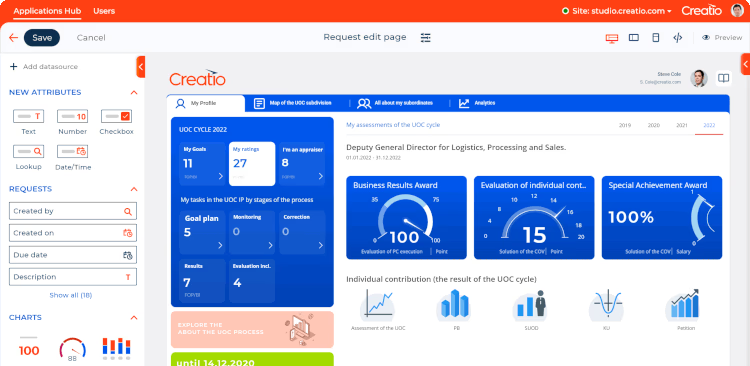Just How No-Code Devices Simplify Open Platform Database Development for Everybody
Just How No-Code Devices Simplify Open Platform Database Development for Everybody
Blog Article
A Comprehensive Overview to Executing Scalable Data Sources Without the Demand for Coding Experience
In the modern landscape of information administration, the capacity to carry out scalable databases without coding proficiency is ending up being significantly essential for companies of all dimensions. What are the crucial aspects that can really empower these customers to utilize scalable databases properly?
Recognizing Scalable Databases
In the realm of contemporary information monitoring, scalable data sources have arised as a vital service for companies seeking to handle boosting volumes of info efficiently. These data sources are designed to fit development by enabling the smooth addition of sources, whether through straight scaling (including a lot more machines) or upright scaling (upgrading existing equipments) This versatility is essential in today's busy digital landscape, where information is generated at an unprecedented price.
Scalable databases generally utilize distributed styles, which make it possible for information to be spread throughout multiple nodes. This circulation not just enhances performance yet also offers redundancy, making certain information availability even in case of equipment failures. Scalability can be an essential factor for different applications, consisting of shopping platforms, social networks networks, and huge information analytics, where user demand can rise and fall considerably.
In addition, scalable databases usually feature robust data consistency versions that balance performance and reliability. Organizations has to consider their specific requirements, such as read and compose rates, information honesty, and fault tolerance when selecting a scalable database service. Inevitably, understanding the underlying principles of scalable data sources is important for services aiming to prosper in an increasingly data-driven world.
Key Attributes to Seek
When reviewing scalable data sources, numerous crucial functions are extremely important to making certain optimum performance and reliability. Think about the design of the database. A distributed style can improve scalability by allowing data to be saved across multiple nodes, facilitating smooth information access and handling as need increases.
An additional essential function is data dividing, which allows efficient monitoring of big datasets by dividing them right into smaller, much more manageable items (no-code). This strategy not only improves efficiency however likewise streamlines source allotment
Furthermore, try to find durable replication capabilities. This function makes certain information redundancy and high availability, decreasing downtime during upkeep or unexpected failings.
Efficiency surveillance devices are also vital, as they provide real-time insights into system wellness and operational effectiveness, allowing for timely adjustments to maintain ideal efficiency.

User-Friendly Database Tools
Simpleness is a critical component in the layout of straightforward data source tools, as it enhances ease of access for customers with varying degrees of technological knowledge. no-code. These devices focus on user-friendly user interfaces, allowing individuals to create, manage, and inquiry databases without requiring substantial programming knowledge
Secret attributes typically include drag-and-drop functionality, visual information modeling, and pre-built design templates that simplify the arrangement procedure. Such devices commonly provide directed tutorials or onboarding processes that promote individual involvement and minimize the learning curve. Furthermore, seamless assimilation with popular information resources and services makes sure that users can quickly import and export information, further simplifying procedures.

Moreover, robust assistance and neighborhood resources, such as discussion forums and documentation, boost the individual experience by giving support read this when needed. On the whole, user-friendly data source tools empower organizations to harness the power of scalable databases, making data administration easily accessible to everybody entailed.
Step-by-Step Application Guide
Exactly how can organizations properly execute scalable data sources to satisfy their expanding data demands? The process starts with recognizing certain information demands, consisting of the volume, range, and velocity of data that will certainly be processed. Next off, organizations need to examine user-friendly database devices that provide scalability attributes, such as cloud-based remedies or handled data source services.
Once the appropriate device is chosen, the next action involves setting up the database environment. This consists of setting up circumstances, defining individual authorizations, and establishing information structures that straighten with company purposes. Organizations ought to after that migrate existing information into the brand-new system, making certain data integrity and very little disturbance to operations.
Post-migration, performing thorough screening is important; this consists of performance testing under numerous tons problems to guarantee the system can deal with future growth - no-code. In addition, it is very important to educate staff on the database monitoring interface to assist in smooth use
Ideal Practices for Monitoring
Reliable monitoring of content scalable databases requires a tactical method that prioritizes continuous surveillance and optimization. To attain this, organizations ought to carry out durable monitoring tools that provide real-time insights into database performance metrics, such as question response times, resource utilization, and transaction throughput. On a regular basis assessing these metrics can aid identify traffic jams and locations for enhancement.

Regular backups and catastrophe recuperation strategies are vital to guard data stability and accessibility. Developing a regular for page testing these backups will make sure a dependable healing procedure in instance of an unanticipated failing.
In addition, performance adjusting ought to be a continual process. Adjusting indexing approaches, enhancing queries, and scaling resourcesâEUR" whether up and down or horizontallyâEUR" will aid preserve optimum performance as use demands advance.
Finally, fostering a society of expertise sharing among employee will make it possible for continual learning and adaptation, ensuring that the administration of scalable data sources remains effective and effective with time.
Conclusion
Finally, the execution of scalable databases can be successfully attained without coding know-how through the usage of intuitive interfaces and straightforward devices. By sticking to the outlined methods for arrangement, information movement, and efficiency testing, individuals can navigate the complexities of data source monitoring with ease. Highlighting ideal techniques for ongoing upkeep and partnership additional boosts the capacity to manage scalable databases effectively in a quickly developing data-driven environment.
In the modern landscape of data management, the ability to implement scalable databases without coding competence is ending up being significantly important for organizations of all sizes.In the realm of modern information monitoring, scalable data sources have emerged as an important service for organizations seeking to handle raising quantities of info effectively.Additionally, scalable data sources often include durable data consistency versions that stabilize performance and reliability.Just how can companies efficiently implement scalable data sources to satisfy their growing information demands? Next, organizations should examine easy to use data source devices that provide scalability functions, such as cloud-based solutions or managed database services.
Report this page